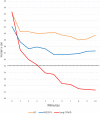Orthostatic Challenge Causes Distinctive Symptomatic, Hemodynamic and Cognitive Responses in Long COVID and Myalgic Encephalomyelitis/Chronic Fatigue Syndrome
- PMID: 35847821
- PMCID: PMC9285104
- DOI: 10.3389/fmed.2022.917019
Orthostatic Challenge Causes Distinctive Symptomatic, Hemodynamic and Cognitive Responses in Long COVID and Myalgic Encephalomyelitis/Chronic Fatigue Syndrome
Abstract
Background: Some patients with acute COVID-19 are left with persistent, debilitating fatigue, cognitive impairment ("brain fog"), orthostatic intolerance (OI) and other symptoms ("Long COVID"). Many of the symptoms are like those of other post-infectious fatigue syndromes and may meet criteria for myalgic encephalomyelitis/chronic fatigue syndrome (ME/CFS). Common diagnostic laboratory tests are often unrevealing.
Methods: We evaluated whether a simple, standardized, office-based test of OI, the 10-min NASA Lean Test (NLT), would aggravate symptoms and produce objective hemodynamic and cognitive abnormalities, the latter being evaluated by a simple smart phone-based app.
Participants: People with Long COVID (N = 42), ME/CFS (N = 26) and healthy control subjects (N = 20) were studied just before, during, immediately after, 2 and 7 days following completion of the NLT.
Results: The NLT provoked a worsening of symptoms in the two patient groups but not in healthy control subjects, and the severity of all symptoms was similar and significantly worse in the two patient groups than in the control subjects (p < 0.001). In the two patient groups, particularly those with Long COVID, the NLT provoked a marked and progressive narrowing in the pulse pressure. All three cognitive measures of reaction time worsened in the two patient groups immediately following the NLT, compared to the healthy control subjects, particularly in the Procedural Reaction Time (p < 0.01).
Conclusions: A test of orthostatic stress easily performed in an office setting reveals different symptomatic, hemodynamic and cognitive abnormalities in people with Long COVID and ME/CFS, compared to healthy control subjects. Thus, an orthostatic challenge easily performed in an office setting, and the use of a smart phone app to assess cognition, can provide objective confirmation of the orthostatic intolerance and brain fog reported by patients with Long COVID and ME/CFS.
Keywords: autonomic nervous system dysfunction; chronic fatigue syndrome (CFS); long COVID; myalgic encephalomyelitis; orthostatic intolerance (OI); post-acute sequelae of SARS-CoV-2 infection (PASC); postural orthostatic tachycardia syndrome (POTS).
Copyright © 2022 Vernon, Funk, Bateman, Stoddard, Hammer, Sullivan, Bell, Abbaszadeh, Lipkin and Komaroff.
Conflict of interest statement
The authors declare that the research was conducted in the absence of any commercial or financial relationships that could be construed as a potential conflict of interest.
Figures


Similar articles
-
Cognitive impairment in post-acute sequelae of COVID-19 and short duration myalgic encephalomyelitis patients is mediated by orthostatic hemodynamic changes.Front Neurosci. 2023 Jun 26;17:1203514. doi: 10.3389/fnins.2023.1203514. eCollection 2023. Front Neurosci. 2023. PMID: 37434760 Free PMC article.
-
Orthostatic Symptoms and Reductions in Cerebral Blood Flow in Long-Haul COVID-19 Patients: Similarities with Myalgic Encephalomyelitis/Chronic Fatigue Syndrome.Medicina (Kaunas). 2021 Dec 24;58(1):28. doi: 10.3390/medicina58010028. Medicina (Kaunas). 2021. PMID: 35056336 Free PMC article.
-
Association of circulating biomarkers with illness severity measures differentiates myalgic encephalomyelitis/chronic fatigue syndrome and post-COVID-19 condition: a prospective pilot cohort study.J Transl Med. 2024 Apr 10;22(1):343. doi: 10.1186/s12967-024-05148-0. J Transl Med. 2024. PMID: 38600563 Free PMC article.
-
Redox imbalance links COVID-19 and myalgic encephalomyelitis/chronic fatigue syndrome.Proc Natl Acad Sci U S A. 2021 Aug 24;118(34):e2024358118. doi: 10.1073/pnas.2024358118. Proc Natl Acad Sci U S A. 2021. PMID: 34400495 Free PMC article. Review.
-
Exercise Pathophysiology in Myalgic Encephalomyelitis/Chronic Fatigue Syndrome and Postacute Sequelae of SARS-CoV-2: More in Common Than Not?Chest. 2023 Sep;164(3):717-726. doi: 10.1016/j.chest.2023.03.049. Epub 2023 Apr 11. Chest. 2023. PMID: 37054777 Free PMC article. Review.
Cited by
-
Two neurocognitive domains identified for patients with myalgic encephalomyelitis/chronic fatigue syndrome and post-acute sequelae of COVID-19.Front Neurol. 2025 Jul 15;16:1612548. doi: 10.3389/fneur.2025.1612548. eCollection 2025. Front Neurol. 2025. PMID: 40734821 Free PMC article.
-
The Long or the Post of It? Temporality, Suffering, and Uncertainty in Narratives Following COVID-19.J Med Humanit. 2025 Mar;46(1):3-20. doi: 10.1007/s10912-023-09824-y. Epub 2023 Nov 14. J Med Humanit. 2025. PMID: 37962719 Free PMC article.
-
Core features and inherent diversity of post-acute infection syndromes.Front Immunol. 2025 Jun 3;16:1509131. doi: 10.3389/fimmu.2025.1509131. eCollection 2025. Front Immunol. 2025. PMID: 40529374 Free PMC article. Review.
-
Overlapping conditions in Long COVID at a multisite academic center.Front Neurol. 2024 Oct 25;15:1482917. doi: 10.3389/fneur.2024.1482917. eCollection 2024. Front Neurol. 2024. PMID: 39524912 Free PMC article.
-
Incidence and Prevalence of Post-COVID-19 Myalgic Encephalomyelitis: A Report from the Observational RECOVER-Adult Study.J Gen Intern Med. 2025 Apr;40(5):1085-1094. doi: 10.1007/s11606-024-09290-9. Epub 2025 Jan 13. J Gen Intern Med. 2025. PMID: 39804551 Free PMC article.
References
Grants and funding
LinkOut - more resources
Full Text Sources
Miscellaneous

